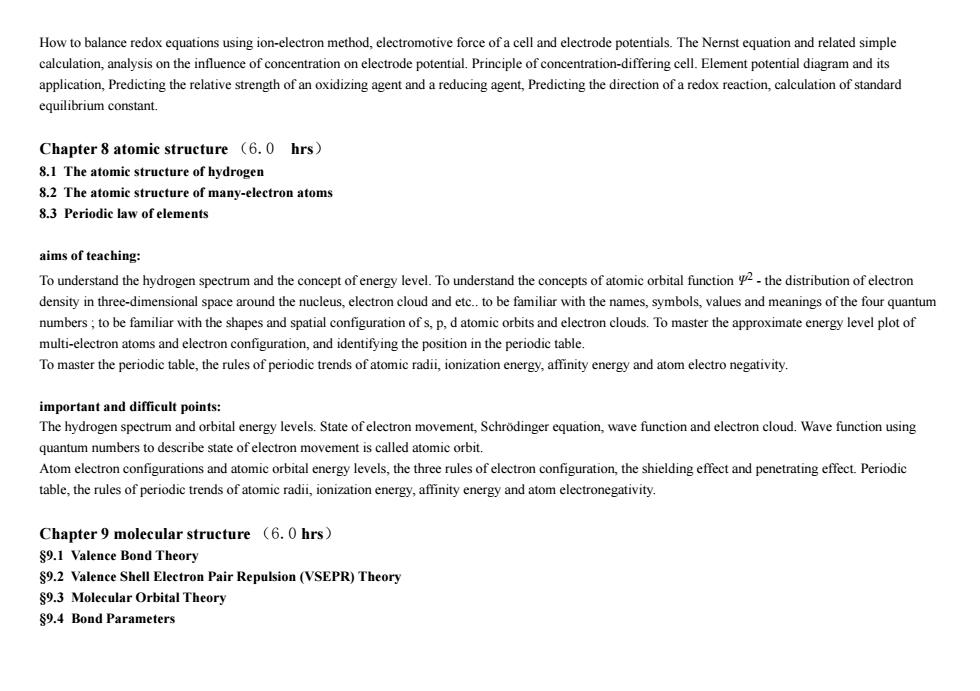正在加载图片...

How to balance redox equations using ion-electron method,electromotive force of a cell and electrode potentials.The Nernst equation and related simple calculation,analysis on the influence of concentration on electrode potential.Principle of concentration-differing cell.Element potential diagram and its application,Predicting the relative strength of an oxidizing agent and a reducing agent,Predicting the direction of a redox reaction,calculation of standard equilibrium constant. Chapter 8 atomic structure (6.0 hrs) 8.1 The atomic structure of hydrogen 8.2 The atomic structure of many-electron atoms 8.3 Periodic law of elements aims of teaching: To understand the hydrogen spectrum and the concept of energy level.To understand the concepts of atomic orbital function y2-the distribution of electron density in three-dimensional space around the nucleus,electron cloud and etc..to be familiar with the names,symbols,values and meanings of the four quantum numbers;to be familiar with the shapes and spatial configuration of s,p,d atomic orbits and electron clouds.To master the approximate energy level plot of multi-electron atoms and electron configuration,and identifying the position in the periodic table. To master the periodic table,the rules of periodic trends of atomic radii,ionization energy,affinity energy and atom electro negativity. important and difficult points: The hydrogen spectrum and orbital energy levels.State of electron movement,Schrodinger equation,wave function and electron cloud.Wave function using quantum numbers to describe state of electron movement is called atomic orbit. Atom electron configurations and atomic orbital energy levels,the three rules of electron configuration,the shielding effect and penetrating effect Periodic table,the rules of periodic trends of atomic radii,ionization energy,affinity energy and atom electronegativity. Chapter 9 molecular structure (6.0 hrs) $9.1 Valence Bond Theory $9.2 Valence Shell Electron Pair Repulsion(VSEPR)Theory $9.3 Molecular Orbital Theory $9.4 Bond ParametersHow to balance redox equations using ion-electron method, electromotive force of a cell and electrode potentials. The Nernst equation and related simple calculation, analysis on the influence of concentration on electrode potential. Principle of concentration-differing cell. Element potential diagram and its application, Predicting the relative strength of an oxidizing agent and a reducing agent, Predicting the direction of a redox reaction, calculation of standard equilibrium constant. Chapter 8 atomic structure (6.0 hrs) 8.1 The atomic structure of hydrogen 8.2 The atomic structure of many-electron atoms 8.3 Periodic law of elements aims of teaching: To understand the hydrogen spectrum and the concept of energy level. To understand the concepts of atomic orbital function Ψ 2 - the distribution of electron density in three-dimensional space around the nucleus, electron cloud and etc.. to be familiar with the names, symbols, values and meanings of the four quantum numbers ; to be familiar with the shapes and spatial configuration of s, p, d atomic orbits and electron clouds. To master the approximate energy level plot of multi-electron atoms and electron configuration, and identifying the position in the periodic table. To master the periodic table, the rules of periodic trends of atomic radii, ionization energy, affinity energy and atom electro negativity. important and difficult points: The hydrogen spectrum and orbital energy levels. State of electron movement, Schrödinger equation, wave function and electron cloud. Wave function using quantum numbers to describe state of electron movement is called atomic orbit. Atom electron configurations and atomic orbital energy levels, the three rules of electron configuration, the shielding effect and penetrating effect. Periodic table, the rules of periodic trends of atomic radii, ionization energy, affinity energy and atom electronegativity. Chapter 9 molecular structure (6.0 hrs) §9.1 Valence Bond Theory §9.2 Valence Shell Electron Pair Repulsion (VSEPR) Theory §9.3 Molecular Orbital Theory §9.4 Bond Parameters